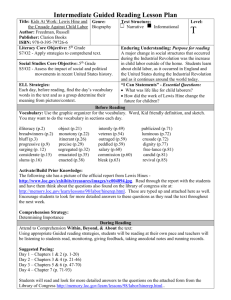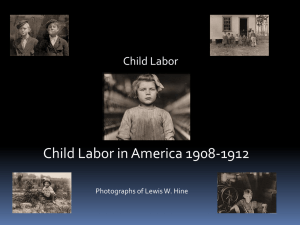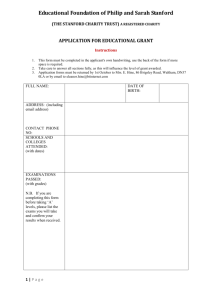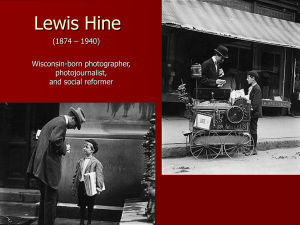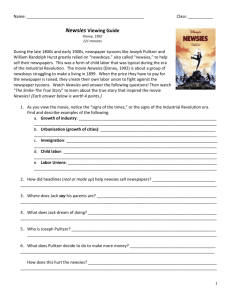Child Labor Bibliography
advertisement
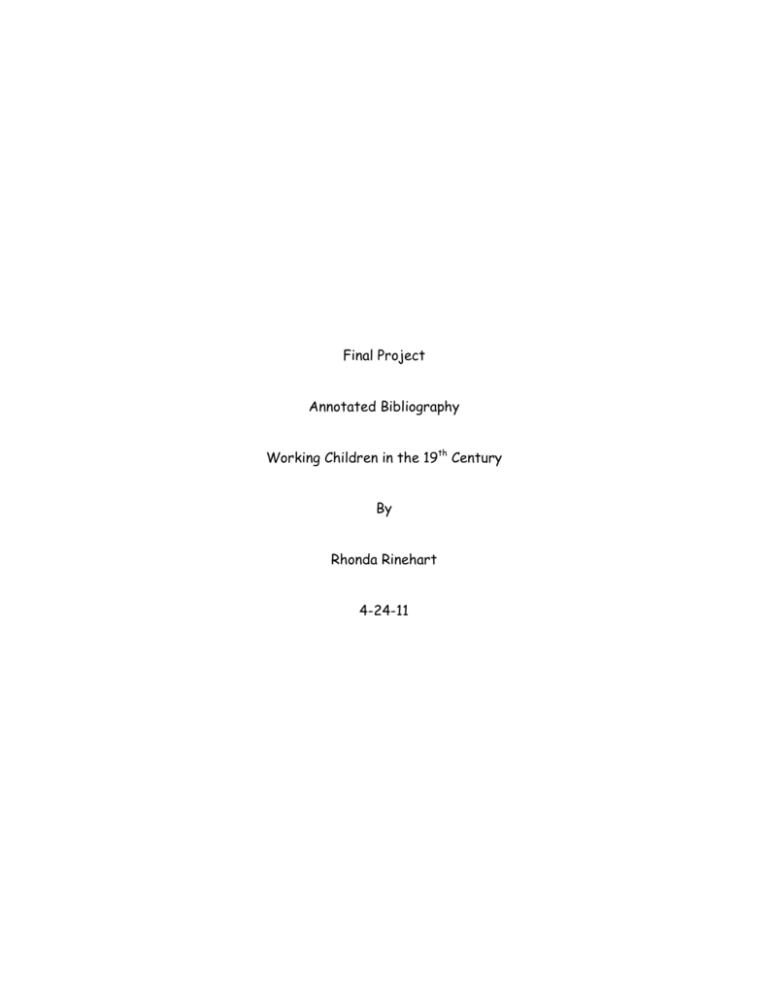
Final Project Annotated Bibliography Working Children in the 19th Century By Rhonda Rinehart 4-24-11 Introduction: Economy is a very important part of everyone’s lives. Economics deals with goods, services, trade, characteristics of money, income and their sources, and economic change. A large part of economics is where the income sources come from to buy the goods and services, and if it is bartering or based on a cash system. I feel students need to see the changes that took place in our country over time that now allows them to go to school instead of working to help support their families even at their young age. I want my students to see how their lives would have been much different had they been born in the 19th century and how lucky they are that they weren’t. I think if I knew more about this topic I would be better equipped to teach it to my students. I want my students to know what a luxury it is to go to school and that children in this area did not get to enjoy that luxury in the not so distant past. This project is about children in the work force in the early 19th century in the United States. Bibliography Bartoletti, Susan Campbell. Growing Up in Coal Country. Sandpiper, 1997. This is a student resource meant for students ages 8 to 12. It contains pictures and first- hand accounts of life in the Pennsylvania coal mines. It tells about the different jobs boys held in the mines including; breakers, nippers, spraggers, mule-drivers, and finally, full-fledged miners. Hopefully, this will help give students a small taste of life without child labor laws. —. Kids on Strike. Sandpiper, 2003. This is another student resource by Susan Campbell Bartoletti. This book tells the story of children who stood up for themselves against company owners. It includes stories from the mills in Lowell, Massachusetts to the rent strikes in New York City and the roles children played in this time in history. Brown, Dan. Kid Blink Beats The World. Roaring Book Press, 2004 This is a picture book for younger students about kids who sell newspapers, Newsies, on the street corners and how they organized a strike against William Randolph Hearst and Joseph Pulitzer. A story about how much a penny is worth to a millionaire and a poor "newsie". Coulter, Laurie. Cowboys and Coffin Makers: One Hundred 19th-century Jobs You Might Have Feared or Fancied (Jobs in History).Annick Press March, 2007 This book is meant for use in grades 3 through 6. It contains jobs a person might have held in the 19th century and their descriptions. This might be used to introduce to students that children did work instead of going to school and these are some of those jobs. These are, however, not just jobs for children. Currie, Stephen. We Have Marched Together: The Working Children's Crusade. Learner Publishing Group, April 1997 For older students, this book tells the story of a dramatic protest march of child textile workers who walk from Philadelphia to New York in 1903 led by Mother Jones. This book also includes photos by Lewis Hine. Freedman, Russell. Kids at Work: Lewis Hine and the Crusade Against Child Labor. Sandpiper, 1998. This is also a student resource. It is meant for students in grades 5 and up. It is about Lewis Hine and the part he and his camera played in exposing the harsh conditions under which children were working during the early 1900's. Freedman wrote this for children of today so that they may understand what life would have been like for them had been born in an earlier time. Fresch, Eula. Connecting Children with Children Past and Present. Heinemann, 2004. This book is for teacher use. It contains archival and contemporary material about child labor, links to national standards, an annotated bibliography, and classroom examples. It also includes way to role play, how to interpret letters and diaries, as well as how to analyze photos. Gorn, Elliott J. Mother Jones: The Most Dangerous Woman in America. Hill an Wang, April 2002 This biography is a teacher resource. It is about Mary Jones who became known as Mother Jones. She was one of the most famous union organizers in the early 1900's. For her part in the child labor battle she organized a march of child textile workers from Pennsylvania to New York to protest the conditions under which children were forced to work. This march brought to light the issues of child labor into the public eye. Herndon, Ruth Wallis. Children Bound to Labor. Cornell University Press, 2009. This is another teacher resource that would be great to help a teacher build his or her background knowledge on child labor. It is about how some children were forced into working in harsh conditions simply because of the circumstances under which they were born, such as, illegitimate births, abandonment, or abuse. Hindman, Hugh D. Child Labor an American History. M.E. Sharpe, 2002. This book would also be a good resource for teachers to build background knowledge. The author uses photographs from Lewis Hine's investigations for the National Child Labor Committee as well as the 19volume investigative report provided by the NCLC to delve into this time in American history. Mofford, Juliet. Child Labor in America (Perspectives on History). History Compass, 1970. This book could be for teachers or older students. It is about the places and conditions in which children worked in the early 1900's. It includes first-hand accounts from the working children as well as from their bosses. Paterson, Katherine. Lyddie. Puffin, September, 2004 This is a work of fiction for students 5th grade and up. It is a story about Lyddie, who along with her brother, has been hired out as a servant after their father abandoned the family and their mother and younger siblings went to live with other relatives. She eventually finds herself in Lowell, Massachusetts working in the mills. She is trying to save enough money to buy back her farm and reunite her family. Saller, Carol. Working Children (Picture the American Past). Carolrhoda Books, 1998. This book could be a teacher resource as well as a student resource. It includes pictures by Lewis Hine along with stories from the children themselves. It could be used by the students as a research tool or by teachers to build up their background knowledge. It also includes some ideas on writing projects for students in its "Note to Teachers and Adults" section. Winthrop, Elizabeth. Counting on Grace. Yearling, 2007. This is another work of fiction suitable for students 5th grade and up. It is based in reality; a photo taken by Lewis Hine of a French-Canadian girl working in a textile mill is the inspiration for a story about Grace. Grace is forced to leave school in order to work in the mill with her mother. It is told from Grace's point of view. DVD Newsies, DVD, directed by Kenny Ortega, Walt Disney Video, Released 2002 This movie musical is based on the newsies, kids who sell newspapers on the streets, strike against Pulitzer and Hearst in 1899. The DVD also includes three featurettes: "Newsies, Newsies, Read All About It", "Newsies, The Inside Story", and "The Strike, The True Story". Websites Shelton, Mitchell R.K. "Child Labor and Child Labor Reform in American History." Revised Feb. 2006. http://ehistory.osu.edu/osu/mmh/childlabor/mrcoal.cfm (accessed April 21, 2011) This is a story about a coal mine in Pennsylvania. It features photos of children with captions of the work they are doing. It is told from the point of view of a piece of coal. This would be an excellent resource for students in upper elementary. It would also be better used with male students. It was scanned from the Child Labor Bulletin (7 volumes published between June 1912 and Feb. 1919 by the National Child Labor Committee. http://ehistory.osu.edu/osu/mmh/childlabor/cottondress.cfm (accessed April 21, 2011) This is another story scanned from the Child Labor Bulletin titled "The Story of My Cotton Dress" written in August of 1914. This story is told by a girl who owns a cotton dress and since she went on a trip to Atlanta and knows where the cotton came from to make her dress she wants to take better care of it. The story features photos of children in cotton fields, in the textile mills and in the tenements. This story would be great to use with female students. ? Tracey. "19th Century America." Updated July 30, 2006. http://www.teacheroz.com/19thcent.htm (accessed April 21, 2011) This site has several links to child labor in the 19th century. Although some of links have been deleted there are some that could still be used for teachers for collecting background information. It includes primary documents, timelines, maps, and much more. "The Industrial Revolution in the United States" http://www.loc.gov/teachers (accessed April 21, 2011) Once you get to this part of the web site you will need to click on Primary Source Sets, and then click on industrial revolution. Once you get here you will find the teacher's guide. This will give you lesson plans as well as printable worksheets. This site includes several primary sources to use when studying child labor. Including typed reports from Lewis Hine to the National Child Labor Committee on what he found as he investigated factories. It also includes photos of breaker boys in coal mines, and a newspaper clipping of Mrs. Langdon Stewardson requesting funds for the NCLC. "Florence Kelly on Child Labor." http://memory.loc.gov/master/rbc/rbcmil/scrp1015201/001.jpg (accessed April 22, 2011) This is a primary source. It is a clipping from a newspaper from Miller NAWSA Suffrage Scrapbook, 18971911. It is about Mrs. Kelly's lecture on child labor. She was the secretary of the National Consumers League and she spent much of her time inspecting factories to see if the laws on child labor were being followed. "Child Labor in the Cotton Mills of Mississippi." http://www.loc.gov/exhibits/treasures/images/vc004894.jpg (accessed April 21, 2011) This is another primary source item. It is a report typed by Lewis Hine for the National Child Labor Committee. It also gives several references to photos he had taken of these conditions. However, I was not able to locate those specific photos here. "Child Labor in America 1908 - 1912" http://www.historyplace.com (accessed April 22, 2011) The website listed above takes you to a home page for several different sections of history related topics. Once you get to this page you will need to scroll down until you find the above title which you will then click on. It features photos by Lewis Hine along with the original captions. It includes photos from textile mills, newsies, miners, factories, seafood workers, field and farm workers, salesman and many others. There are also photos of families, pastimes, and vices. "Keating-Owen Child Labor Act of 1916." http://www.ourdocuments.gov (accessed April 21, 2011) The above site is for the main page, once you get here you will see several selections on the right side, choose 100 documents, then scroll down until you see Keating-Owen Act of 1916. This is a primary government document of the law that limited the number of hours a child can work as well as outlawing interstate sale of goods produced by child labor. "Child Labor in the Gulf Coast 1913." http://www.loc.gov/exhibits/treasures/images/s55.4a.jpg (accessed April 21, 2011) This is a primary source that contains a typed report by Edward Brown about his conversation with a factory manager about having children on the premises. The manager says that he might as well get them to work because they are there anyway. "America at Work, America at Leisure: Motion Pictures from 1894 to 1915." camera: G.W. "Billy" Bitzer, Arthur Marvin, "Delivering Newspapers" copyright: American Mutoscope & Biograph Co; 24 Apr, 1903.http://memory.loc.gov/cgi-bin/query (accessed April 22, 2011) This is a film strip possibly filmed in Union Square. It shows a one-horse paneled newspaper van pull up and about 50 boys run up to it. In the back of the van a fight breaks out between two boys. On the side of the van is a sign that reads "New York World". Conclusion: I have learned so many things since I started this class. Probably the most disturbing thing is that I am not proud to call myself a "white American". We are considered a super power around the world but as I learn more and more about how we got there I'm wondering how "super" it all is. It seems to me that "white" people got where they are on the backs of others. That does not make me proud. I have also learned that women were very instrumental in getting this country where it is today and we are not given the credit we deserve. As I researched my topic on child labor I learned that children's lives in the country's beginning were not easy lives to live. I never thought about there being illegitimate births or abandonment and then that those children were basically sold into slavery. Maybe not the same type of slavery we read about in "Diary of a Slave Girl" but very similar. We have come such a long way as a country and I hope that we can learn from our mistakes so that we do not repeat them.
